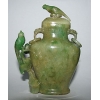|
 Jadeite is the
semi-precious ornamental stone resembling greenstone but with the other
components inside. On the top of it, jadeite is rarely discovered unlike
greenstone. In the earlier time greenstone and jade were referred to one class
minerals, now jade is only jadeite not other stones. Jade was considered as the
sacred stone from the time immemorial and our forefathers believed that this
stone is able to influence the weather and treat various diseases. The precise name
of the stone is not known. Jadeite is the
semi-precious ornamental stone resembling greenstone but with the other
components inside. On the top of it, jadeite is rarely discovered unlike
greenstone. In the earlier time greenstone and jade were referred to one class
minerals, now jade is only jadeite not other stones. Jade was considered as the
sacred stone from the time immemorial and our forefathers believed that this
stone is able to influence the weather and treat various diseases. The precise name
of the stone is not known.
Some surveyors
suppose that jadeite is named after the Greek word «ishias» which means thigh
ache treated by the jade, while other proposed that the name of the stone comes
from the Spanish «piedro de jadee» meaning kidney stone or stone to treat colic.
The
Indians, natives of the Central America,
believed that jadeite is good to treat kidney diseases and the stone was highly
estimated. Historians state that every head of the tribe and every local «king»
should have had at least one decoration from jadeite and also their wives wore jadeite
decorations.
Jadeite was
the most popular stone in the East. Chinese and Japanese Emperor valued
jadeite
to the extent that they wore jadeite decorations and also they slept on
jade
pillows and ate from jadeite dishes. Such an unusual favor to the stone
refers to the belief in favorable effect of the stone to health of the
bearer. Yet, if the stone is close to the body or contacts
with the skin, it is even better. On the top of it, the ancient people
believed
that jadeite is faithful to the stone owner and if necessary it can
save life
to the owner breaking down in pieces which meant that jadeite saved its
owner
from death.
Litotherapeutists
assume that jadeite strengthens the nervous system, it favorably affects the
vessels, stabilizes the blood pressure, purifies blood, improves sexual potency
with men, helps to get rid of stones from kidney and bile-excreting ducts,
treats kidney and uro-genital diseases. Li Shi Chang who wrote the encyclopedia
for the Emperor Van Li of Min dynasty (1596) stated that «jade grinded into
granules of a rice bean size improves function of lungs, heart, vocal organs
and prolongs life; moreover, it is far more effective when silver or gold is
added to the powder». In addition, special healing drink would be prepared from
the jade to «strengthen muscles, make them flexible, strengthen bones, sedate
thoughts, feed flesh and purify blood. The ones who would take this drink when
traveling never suffered from heat or cold, from hunger or thirst». To make the
original liquor the equal quantity of jadeite, rice and dew were taken, boiled
and filtrated.
Ancient
people believed that the healing properties of the stone increase when the
stone is heated. Thus, jadeite is the most effective stone for faced tiles in saunas.
On the top of it, it looks splendid, and possesses perfect physical and mechanical
characteristics. Scientific investigations proved that jadeite when heated is
the source of inflared rays used in modern physiotherapy procedures when the
stone contacting water releases its metasilicic acid which is healing for the
skin. When heated, sodions and some other microelements like Cu, Ag, Zn, Se and
others penetrate into the organism through the skin surface and stabilize the vegetative-vascular
dystonia.
The most prestigious
and fashionable health complexes offer sauna procedures using jadeite. It takes
you $100 USD an hour to rest in the jadeite sauna Juvenex in New York and despite the crisis situation,
the sauna is always demanded.
The beauty and
benefits of jadeite resulted in that the stone was divided into three classes.
The jewelry stone is «Imperial» of the emerald-green color, half translucent. «Commercial»
of green and grey colors, opaque with thin strings, is used both as ornamental
stone as the jewel. «Utility» class stones are of green to grey colors, nonhomogeneous
tint, is an ordinary ornamental stone.
Inessa Hyder
|